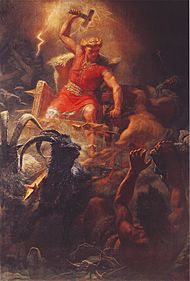Norse mythology facts for kids
Norse mythology is a collection of beliefs and stories from the people of Scandinavia. These tales are a version of older Germanic mythology. Over time, most people in Scandinavia became Christians, and these older beliefs changed or faded away.
The stories of Norse mythology were shared by Germanic tribes in Northern Europe. They weren't written down in a holy book. Instead, people passed them down through generations as poems and songs. This continued through the time of the Vikings. Most of what we know today comes from old writings called the Eddas. These were written down long after people started becoming Christians.
Contents
The Nine Worlds of Norse Mythology
In Norse mythology, people believed the universe had nine different realms, or "worlds." Each world was home to different beings.
Where the Gods Lived
- Asgard was the home of the Æsir, one group of gods. You could only reach Asgard by walking across the Bifröst bridge, which was a rainbow!
- Vanaheimr was the home of the Vanir, another group of gods.
Worlds of Other Beings
- Jötunheimr was the land of the Frost Giants. Its name means "giant realm."
- Niflheim was a cold, dark place ruled by Hel, the daughter of Loki. Many of the dead went to Niflheim.
- Muspelheim was a fiery realm located in the south. It was home to the Fire Giants.
- Midgard was the world where humans lived. It was located between Asgard and Niflheim.
- Álfheimr was the home of the Light Elves.
- Svartálfaheimr was the home of the Dark Elves.
- Niðavellir was the home of the Dwarves.
Gods and Other Creatures

There were two main groups of gods: the Æsir and the Vanir. After a long war, these two groups made peace and joined together. They often fought against the Jötnar, who are also called giants. Interestingly, some gods, like Odin, were descendants of giants. Both the Æsir and Vanir sometimes married giants. There were two kinds of giants: Frost Giants and Fire Giants.
Many other amazing creatures lived in the Norse worlds:
- Fenrir was a huge, powerful wolf.
- Jörmungandr was a giant sea-serpent that was so big it wrapped itself around the entire world.
- Hugin and Munin were two ravens. Their names mean "thought" and "memory." They flew around the world and told Odin everything that was happening.
- Ratatosk was a squirrel that scampered up and down the world tree, Yggdrasil.
Most of these stories were told out loud through special poems. Because of this, many details have been lost over time. Some stories were written down by Christian scholars later on. The most detailed records come from the Eddas and the Heimskringla by Snorri Sturluson. We also know about Norse mythology from runestones and image stones that show scenes like Thor's fishing trip.
Norse Mythology in Our World Today
| Day (Norwegian) | Origin |
|---|---|
| Søndag | The Sun's day |
| Måndag | Moon's day |
| Tisdag | Tyr's day |
| Onsdag | Odin's day |
| Torsdag | Thor's day |
| Fredag | Freyja or Frigg's day |
| Lørdag | Day of Saturn (English and Dutch languages), day of bath (Swedish and Danish languages), Sabbath (German language) |
The old Germanic gods have influenced our daily lives in many countries, especially those that speak Germanic languages like English. A great example is the names of some days of the week!
The Romans named their days after their own gods (like Sun, Moon, Mars, Mercury, Jupiter, Venus, and Saturn). But in Germanic languages, the names for Tuesday through Friday were changed to honor Norse gods:
- Tuesday comes from Týr's day.
- Wednesday comes from Odin's day.
- Thursday comes from Thor's day.
- Friday comes from Freyja or Frigg's day.
In English, Saturday kept its Roman name, Saturn's day. In other languages, Saturday might be named after the Sabbath or even "washing day" in Scandinavia.
Norse Mythology in Popular Culture
Norse myths have also had a big impact on modern stories and movies. For example, J. R. R. Tolkien's famous books, The Lord of the Rings, were greatly inspired by these myths. When his books became popular, many ideas from his fantasy world became common in other fantasy stories.
Today, you can find creatures from Norse mythology in almost any modern fantasy novel, movie, or game. Think about elves, dwarves, and giants – they all have roots in these ancient Norse tales!
Images for kids
-
The cosmological, central tree Yggdrasil is depicted in The Ash Yggdrasil by Friedrich Wilhelm Heine (1886)
See also
 In Spanish: Mitología nórdica para niños
In Spanish: Mitología nórdica para niños






